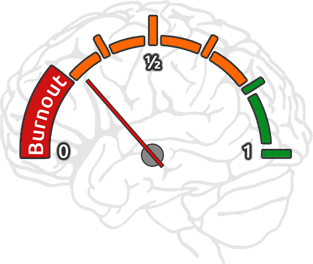Ergebnisse und Publikationen
Erste Studienergebnisse der Dresdner Burnout Studie wurden bereits veröffentlicht. Unter den folgenden Angaben finden Sie die Publikationen:
2021
Rothe, N., Vogel, S., Schmelzer, K., Kirschbaum, C., Penz, M., Wekenborg, M. K., Gao, W., Walther, A. (2021). The moderating effect of cortisol and dehydroepiandrosterone on the relation between sleep and depression or burnout. Comprehensive Psychoneuroendocrinology, 100051. https://doi.org/10.1016/j.cpnec.2021.100051
2020
Gao, W., Walther, A., Wekenborg, M., Penz, M., & Kirschbaum, C. (2020). Determination of endocannabinoids and N-acylethanolamines in human hair with LC-MS/MS and their relation to symptoms of depression, burnout, and anxiety. Talanta, 217, 121006. https://doi.org/10.1016/j.talanta.2020.121006
Rothe, N., Steffen, J., Penz, M., Kirschbaum, C., Walther, A. (2020). Examination of peripheral basal and reactive cortisol levels in major depressive disorder and the burnout syndrome: A systematic review. Neuroscience & Biobehavioral Reviews 114, 232-270. https://doi.org/10.1016/j.neubiorev.2020.02.024
Rothe, N., Schulze, J., Kirschbaum, C., Buske-Kirschbaum, A., Penz, M., Wekenborg, M. K., & Walther, A. (2020). Sleep disturbances in major depressive and burnout syndrome: A longitudinal analysis. Psychiatry Research, 286, 112868. https://doi.org/10.1016/j.psychres.2020.112868
Walther, A., Wehrli, S., Kische, H., Penz, M., Wekenborg, M., Gao, W., ... & Kirschbaum, C. (2020). Depressive symptoms are not associated with long-term integrated testosterone concentrations in hair. The World Journal of Biological Psychiatry, 1-13. https://doi.org/10.1080/15622975.2020.1795253
2019
Gao, W., Penz, M., Wekenborg, M., Walther, A., & Kirschbaum, C. (2019). Determination of thyroid hormones in human hair with online SPE LC–MS/MS: Analytical protocol and application in study of burnout. Psychoneuroendocrinology, 106, 129-137. https://doi.org/10.1016/j.psyneuen.2019.03.032
Penz, M., Siegrist, J., Wekenborg, M. K., Rothe, N., Walther, A., & Kirschbaum, C. (2019). Effort-reward imbalance at work is associated with hair cortisol concentrations: Prospective evidence from the Dresden Burnout Study. Psychoneuroendocrinology, 109, 104399. https://doi.org/10.1016/j.psyneuen.2019.104399
Wekenborg, M.K., Hill, L.K., Thayer, J.F., Penz, M., Wittling, R.A., Kirschbaum, C. (2019). The Longitudinal Association of Reduced Vagal Tone with Burnout. Psychosom Med. 2019 Nov/Dec;81(9):791-798. https://doi.org/10.1097/PSY.0000000000000750.
Wekenborg, M.K., von Dawans, B., Hill, L.K., Thayer, J.F., Penz, M., Kirschbaum, C. (2019). Examining reactivity patterns in burnout and other indicators of chronic stress. Psychoneuroendocrinology. 2019 Aug;106:195-205. https://doi.org/10.1016/j.psyneuen.2019.04.002
2018
Penz, M., Wekenborg, M. K., Pieper, L., Beesdo-Baum, K., Walther, A., Miller, R., Stalder, T., & Kirschbaum, C. (2018). The Dresden Burnout Study: Protocol of a prospective cohort study for the bio-psychological investigation of burnout. International journal of methods in psychiatric research, e1613. http://doi.org/10.1002/mpr.1613
Penz, M., Kirschbaum, C., Buske-Kirschbaum, A., Wekenborg, M. K., & Miller, R. (2018). Stressful life events predict one-year change of leukocyte composition in peripheral blood. Psychoneuroendocrinology, 94, 17-24https://doi.org/10.1016/j.psyneuen.2018.05.006
Wekenborg, M. K., Hill, L. K., Miller, R., Stalder, T., Thayer, J. F., Sophie Penz, M., & Kirschbaum, C. (2018). Reduced self-regulation mirrors the distorting effects of burnout symptomatology on task difficulty perception during an inhibition task. Stress, 1-9. https://doi.org/10.1080/10253890.2018.1479393
2017
Kanthak, M. K., Stalder, T., Hill, L. K., Thayer, J., Penz, M., & Kirschbaum, C. (2017). Autonomic dysregulation in burnout and depression: evidence for the central role of exhaustion. Scand J Work Environ Health, 41(6), 0–10. http://doi.org/10.5271/sjweh.3647
Penz, M., Stalder, T., Miller, R., Vera, M., Kanthak, M. K., & Kirschbaum, C. (2017). Hair cortisol as a biological marker for burnout symptomatology. Psychoneuroendocrinologyhttp://doi.org/10.1016/j.psyneuen.2017.07.485
Penz, M., & Walther, A. (2017). Wie gelangt Burnout in den Körper? - Mögliche Wege zur Somatisierung eines ursprünglich psychologischen Phänomens. Psychologie in Österreich, 242-250. http://www.pioe.at/public/archiv/2017/4/PIOe_2017_4_Penz_Walther_Wie_gelangt_Burnout_in_den_Koerper_Moegliche_Wege_zur_Somatisierung_eines_urspruenglich_psychologischen_Phaenomens.pdf
